Last Updated on March 23, 2024 by Masha Eretnova
You look at your painting and sigh a breath of relief at how nice it turned out.
Now you look at your surroundings… and horror strikes as you see bits and blotches of acrylics everywhere–even on yourself. Do you know what to do to clean it? You ask yourself: “How to remove acrylic paint?”
Acrylic paint coats a wide range of surfaces and is made to be “permanent” when it dries but in reality, acrylics are washable if you use the right solution to wash off the paint.
Depending on what kind of surface you’ve spilled the paint on, you may need special products or alternative methods to remove the paint.
9 Common Products That Can Remove Acrylic Paint
Solvents are used to dissolve or soften the dried paint so you can remove them from different objects.
These solvents disrupt the structure of the acrylic polymers which keeps your paint’s shape together when it’s dry.
You can find these solvents in some household items or order them in pharmacies and chemical lab stores.
From weakest to strongest, here are 9 science-backed solvents that can help you remove acrylic paint:
- Rubbing Alcohol (Isopropyl Alcohol) – this acts directly on your acrylic binder. The higher the alcohol percentage, the stronger it is at disrupting your binder. Only safe for synthetic fibers and hard surfaces.
- Denatured Alcohol – it’s stronger than rubbing alcohol as it has less water than rubbing alcohol. However, denatured alcohol comes with methanol, a poisonous and flammable substance.
- Acetone – it’s chemically stronger than alcohol at disrupting your acrylic polymers. Hence it’s used as a nail polish remover but don’t use this on plastic and synthetic surfaces as it can dissolve them in some cases. Acetone attracts the molecules in your acrylic paint stronger than the surface the paint is coated on. So instead of attaching to your canvas or other surfaces, your paint attaches with the acetone solution.
- Ammonia Solution – it stabilizes emulsions in your acrylic paint by raising the pH (it doesn’t let the acrylic polymers stick with one another). This makes it easier to rinse off the paint. Ammonia solution is flammable, however, and has intense fumes.
- Lacquer Thinner – is a strong solvent with toxic ingredients methanol and toluene (the latter can have long-lasting health effects). Nowadays, there are less toxic options that use ethyl acetate instead of toluene.
- Detergent mixture, dish soap, and regular soap work well if we need to remove acrylic paint when it is still wet or semi-dry and on surfaces it doesn’t stick very well like skin, plastic, and some shoes’ materials. But they won’t help if the paint has soaked into the surface and fully dried.
- Vinegar – is an acidic solution and can dissolve acrylic paint and remove it from glass or couches. Works better on non-porous surfaces. The downside is the pungent smell.
- Vegetable oils work amazingly to remove acrylics from softer materials like wood, leather or even our hair. They create a coating around the paint molecules and we can easily wipe it away.
- Hairspray is the weakest product to get rid off acrylics but it can work on clothing.
These items will vary in their effectiveness in removing the paint depending on the surfaces you’re putting them on. Here’s a table comparing how advisable it is to use these solvents on different kinds of surfaces:
| Rubbing Alcohol | Denatured Alcohol | Acetone (or acetone nail polish) | Ammonia Solution | Lacquer Thinner | |
| Skin | / | x | x | x | x |
| Hair | / | x | x | x | x |
| Canvas | / | / | x | x | / |
| Brush | / | / | x | x | x |
| Natural Fabrics (Cotton, Wool, etc.) | / | / | x | / | x |
| Synthetic Fabrics (Polyester, etc.) | / | / | x | / | x |
| Rubber | / | / | x | x | x |
| Leather | / | / | x | x | x |
| Wood | / | / | x | / | / |
| Plastic | / | / | x | / | x |
| Glass | / | / | / | / | / |
| Metal | / | / | / | / | / |
| Hard Surfaces (Concrete, Stone, Tile, etc.) | / | / | / | / | / |
Legend: / – advisable; x – not advisable
If you tried everything and nothing works, either use commercial stain removers or risk and try the strongest solvents like turpentine, gasoline, and kerosene.
How to Remove Acrylic Paint from Clothes and Shoes?
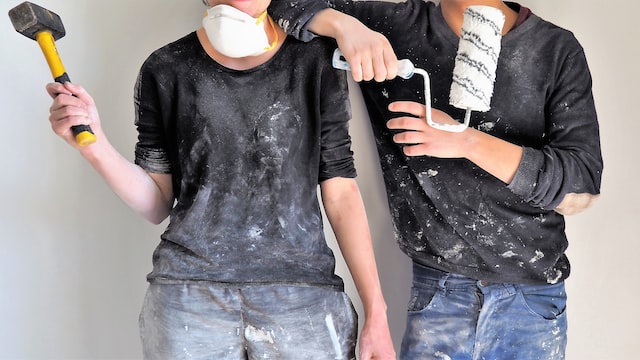
Removing acrylic paint depends on the type of cloth and fabric the paint stays on. But oftentimes, the laundry process and the addition of a fabric softener (like this one from Downy) will remove the stains on your clothes.
- Clothes made from plant-based fabric (cotton, linen, etc.) will have a similar means of removing the acrylic as your canvas–by submerging it in water. The addition of laundry detergent will help remove the paint.
For stubborn acrylic paint stains, use rubbing and denatured alcohol to remove the stains. The alcohol seeps into the seams of your clothes and washes out the paint.
This makes alcohol an ideal choice for fabrics that were heat-setted, a process that makes the paint more permanent on clothes and fabrics, without damaging the fabric strands too much.
If you don’t want to use harsh liquids try mixing vinegar with a dash of salt and rub it into the stain.
- For denim, rubbing alcohol is the best method for removing the paint. Otherwise, placing your stained denim and jeans on the washing machine can easily remove the paint.
For added measure, you can add a stain remover but make sure that your denim and jeans follow the recommended cycle based on their care label.
- To remove dried acrylic from leather clothing or accessories, try using any type of oil. The oils will loosen the grip of the paint on your leather and allow you to scrub them off.
- Vintage clothing. Never soak, only locally apply the stain remover and no harsh solvents. I’ve had a sad experience of trying to clean a vintage kimono I brought from Japan and soaking made it stiff and shrank it and the stain sank even deeper into the fabric.
- Using detergent with water is a good strategy for wearing the paint off most shoes. A sponge, cloth, or an unused toothbrush can be used to apply the detergent. But if you have nappy materials like suede, do not scrub it and use a wool applicator or special Suede shoe cleaner.
For your next project: Can You Use Acrylic Paint on Shoes? Full Guide & Supplies
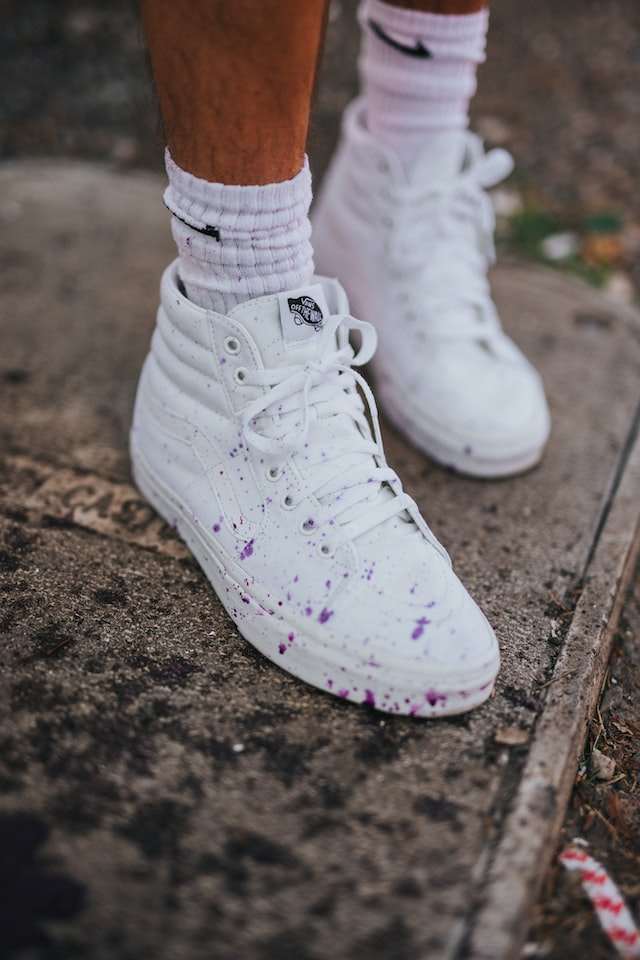
Removing Acrylic Paint From Other Surfaces
Carpet
- First, scrape as much paint with any sharp object. It should be done first to remove the paint on your carpet.
- Apply hydrogen peroxide or rubbing alcohol (depending on your carpet’s fabric) and wipe the stain with a microfiber cloth.
Acetone should be a last-resort option and you should test the carpet for color-fastness (how resistant its color from fading is) first before going all-in on the acetone. Carpets made from fibers that contain acetate, triacetate, or modacrylic can be damaged by acetone, however.
Usually, laundry washing your carpets can also clean the stain regardless of what fabric your carpet was made from.
Couch
- Most couches are padded to protect their frame. If padded with foam, you can get paint off your upholstery by scraping as much paint with a smooth tool first. A stiff brush can be used to pull chunks of paint from the fabric without damaging your couch padding.
Tip: Use circular strokes like whenever you brush your teeth. This movement can lift the dried paint off the fabric on your upholstery.
- After this, blot the stain but don’t rub the stain to prevent spreading the paint. Stain removers or vinegar can be used to help this process.
- Blot the area with a damp towel repeatedly until you remove the paint. This can take several rounds to remove all stains from your couch.
Skin
Acrylic paint can be removed from the skin with soap and water.
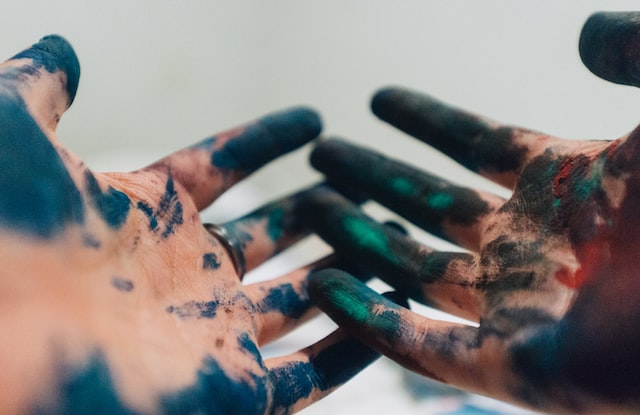
Sometimes when it is dry I can simply rub it off without water.
Read also: 23 Ways How to Get Spray Paint off Skin Safely With Household Products
Hair
- Your regular shampoo will dissolve acrylic paint dried on your hair.
- If you have blotches of paint, while washing your hair, use a comb and gently remove stuck dried pieces.

You might need to do these steps a few more times if you have curly or thicker hair. Use hair treatment oils and conditioners to prevent further damage to your hair. (I use Olaplex series for hair care).
Canvas
Art canvasses are made to hold acrylic paint very well. It is tough to erase acrylics from a canvas, especially once it dries.
The only way to remove dried paint from the canvas (and hopefully not ruin it in the process!) is to soak it for 30 minutes until the paint is soft and scrape it.
I wrote the detailed tutorial here How To Fix Cracked Acrylic Painting in 3 Easy Ways
Plastic
Most acrylics do not stick well to plastic surfaces which makes cleaning it off super easy.
- If you left it dry on your plastic palette you will be able to just peel it off like I did:
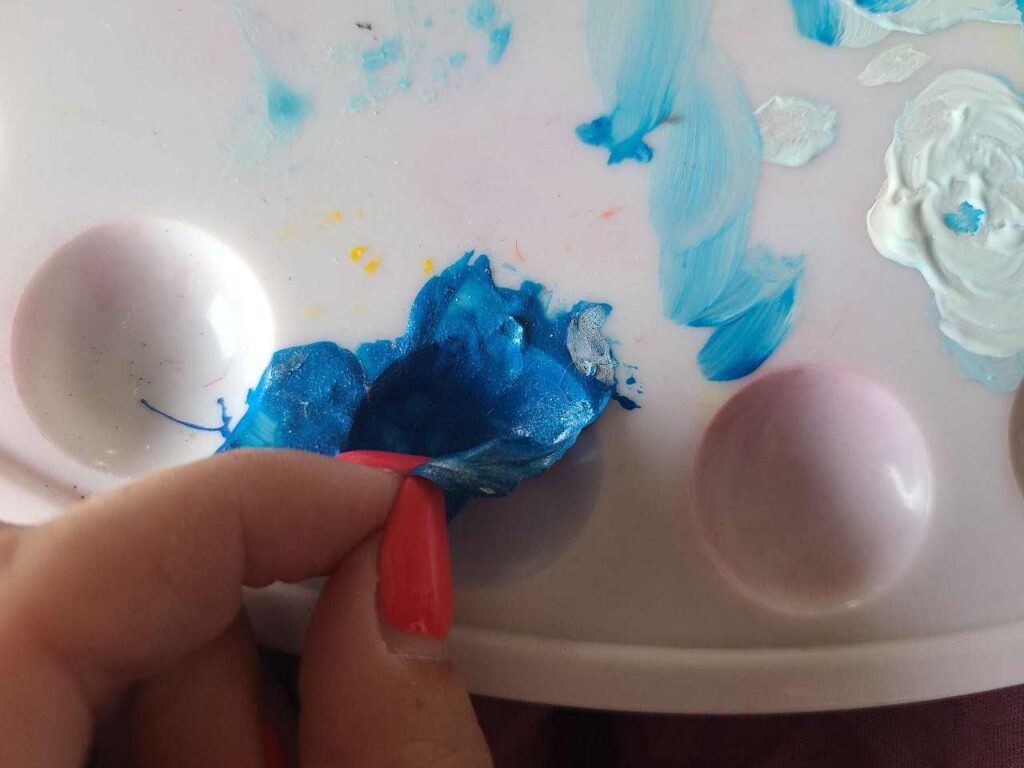
Remember: Solvents should never be used on plastics as they can burn your plastics and release noxious fumes.
Wood
Removing paint from wooden surfaces can be as basic as using oils or soapy water to remove the stain or more intensive like using strong solvents like lacquer and thinner. This will depend on how much paint you want to remove and the thickness of the wood.
What you might not have considered using is a heat gun. A heat gun can be used on larger surfaces and is easier to use on wood oriented vertically.
- Heat up and watch bubbles form. Then scrape the lifted paint.
- Hot water is also the only way to remove paint stains from varnished wood.
If the paint stain on your wooden surfaces is small, washing it off with water, soap and oil is the better option.
If it is a small area, sanding may help. I removed that way unwanted paint and even epoxy from the borders of a wooden tray I was customizing.
Glass
For many glass surfaces, using water will be enough to soften the acrylic paint and you can then scrape off the paint.
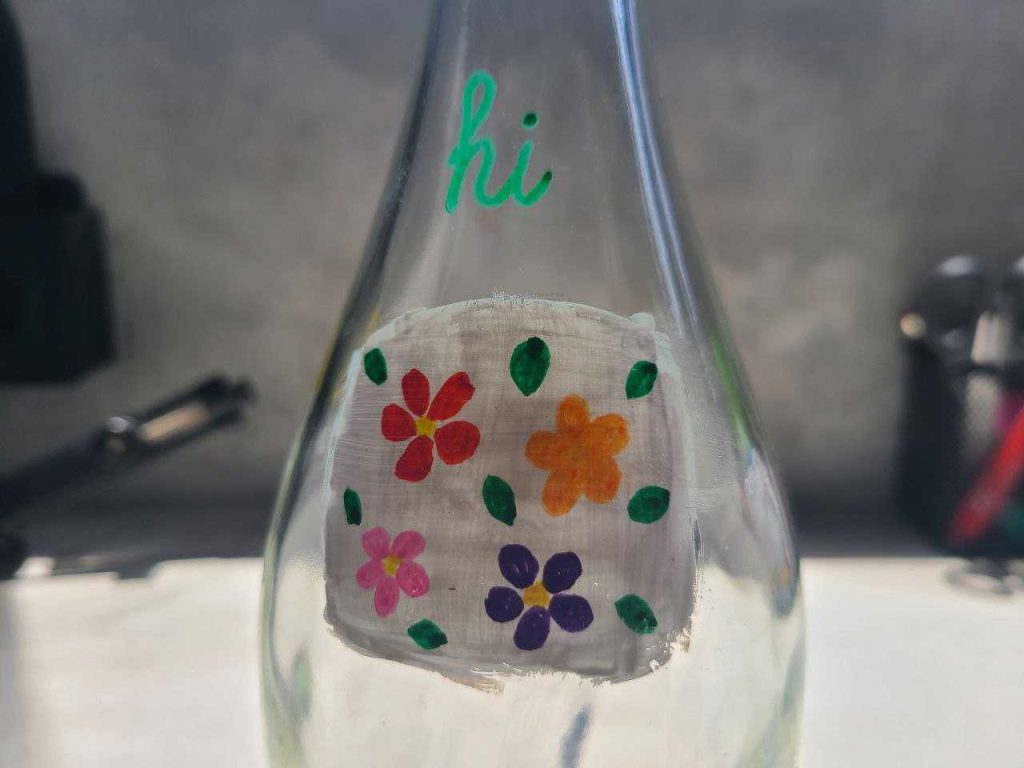
The smooth surface of glass makes it easier to use friction to scrape and remove the paint.
Additionally, glass can withstand the strength of vinegar and nail polish remover so these two household items can be used to remove your dry paint.
A simple window cleaner will work as well as it is exactly what it is designed to do, but act fast.
For stubborn dried acrylics use Stoddard solvent.
Related: Can You Use Acrylic Paint on Glass?
- DO NOT use nail polish remover on any stained glass as you don’t know to also remove the colored coating of the glass.
Concrete
Concrete is very porous and I haven’t had luck removing acrylic paint pen marks from it. But I did remove paint drips.
Regular Isopropyl alcohol or hydrogen peroxide helped me.
Concrete surfaces can also withstand solvents like paint thinners and ammonia so they can be used to remove the paint.
However! We had our concrete house for 2 years and some stains were left by workers. And it was practically impossible to remove them.
Related: 5 Best Paints, Primers, and Sealers For Concrete
Good thing to know: the same methods work on tile, stone, asphalt, and other masonry structures.
Countertops, walls, floors
- If your countertops are made from wood, marble, tile, or concrete, water and soap will remove any acrylic paint that dried on these surfaces.
- Marble, granite, and concrete countertops can withstand lacquer if there are stubborn stains.
- Wooden and acrylic countertops should be cleaned with weaker cleaning agents like oil, soapy water, or specialized paint scrapers.
- A DIY paint remover is to mix half of the water with half industrial vinegar and let it sit over the paint, then wipe.
Note that natural pigments like turmeric are super hard to remove. I’ve used organic pigments once and they stain anything they touch in seconds.

- Bare floors and walls benefit from pressurized water in removing paint stains
- Floors and walls covered with vinyl and linoleum can be cleaned from paint stains by mopping water and detergent on these surfaces. You can allow the detergent mixture to stay longer before rinsing it with water to remove the paint.
You can use cleaning solutions, like this one from Bissel, to remove different stains on different types of wall and floor surfaces.
General Considerations for Removing Acrylic Paint
Tip 1: Use weaker solvents first to remove the paint before using stronger solvents
Tip 2: Dilution will weaken these solvents. In most cases, adding distilled water dilutes the solvents.
Tip 3: If you plan to dilute the solvent, do it incrementally in a 9:1 ratio between your solvent to your distilled water. This prevents your dilute solution from becoming “too weak” at removing the paint.
There are different factors that affect the ease of removing acrylic paint from various surfaces.
Some considerations include:
- The strength of the removing agent you’ll use;
- What material you’ll apply your removing agents on; and;
- How smooth or rough the surface where the paint dries?
How you’ll remove the acrylic paint will vary slightly depending on which product you’ll use to clean a particular surface. But generally, these surfaces fall into two categories: hard and smooth.
- Your hard surfaces will include many stiff surfaces like stone, concrete, and similar objects while your smooth surfaces will include the likes of clothes, leather, and the like.
Hard surfaces will be able to tolerate stronger cleaning agents than smoother surfaces for example.
Another important distinction would be if these surfaces are made from organic (plant-based and animal-based) and inorganic (stone, concrete, synthetic materials) substances as these affect the effectiveness of certain products you’ll use to remove the paint.
Here’s a microbiology tip: For most inorganic surfaces, using hydrogen peroxide is better at cleaning; while for most organic surfaces, it’s better to use alcohol.
This also improves the disinfection properties of these items better.
So, My Verdict: Is Acrylic Paint easy to remove?
Acrylic paint is easy to remove only while it is still wet but becomes difficult to remove when dry.
Once the acrylic is dry we need to break down its bond with the surface to remove it.
Highly reactive products like strong cleaning products (ammonia, etc.) are strong enough to remove the acrylic paint in small amounts from practically any surface.
But because these products are strong, we can’t use them on gentle materials, they can also damage the surface and dull the colors.
Don’t forget that simple tools can help you like a scaper, sponges, or a knife.
Read more: Is Acrylic Paint Waterproof?
For most beginners, I recommend trying water and soap to remove the paint first.
If there are persisting stains, only then proceed to use alternative methods and stronger solutions.
Share your DIY tips in the comments!

Masha Eretnova, born in 1991, is a Buenos Aires-based certified teacher, artist, and member of the Professional Artist Association with 20+ years of personal painting journey.
She started painting and drawing very early and is now an international abstract artist and educator passionate about acrylic painting, gouache, and crafts.
Her works are part of international exhibitions and contests, including ArtlyMix (Brazil), Al-Tiba 9 (Spain), Exhibizone (Canada), Italy, and many more.
Besides her artistic pursuits, Masha holds a post-grad diploma in Teaching Film Photography and 2 music school diplomas: piano and opera singing.